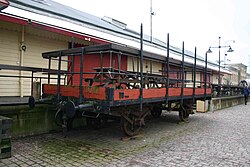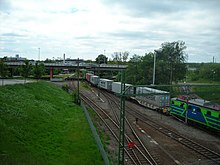Gothenburg harbor railway
| Gothenburg harbor railway | |||||||||||||||||||||||||||||||||||||||||||||||||||||||||||||||||||||||||||||||||||||||||||||||||||||||||||||||||||||||||||||||||||||
|---|---|---|---|---|---|---|---|---|---|---|---|---|---|---|---|---|---|---|---|---|---|---|---|---|---|---|---|---|---|---|---|---|---|---|---|---|---|---|---|---|---|---|---|---|---|---|---|---|---|---|---|---|---|---|---|---|---|---|---|---|---|---|---|---|---|---|---|---|---|---|---|---|---|---|---|---|---|---|---|---|---|---|---|---|---|---|---|---|---|---|---|---|---|---|---|---|---|---|---|---|---|---|---|---|---|---|---|---|---|---|---|---|---|---|---|---|---|---|---|---|---|---|---|---|---|---|---|---|---|---|---|---|---|
|
At the museum harbor (former southern port railway)
| |||||||||||||||||||||||||||||||||||||||||||||||||||||||||||||||||||||||||||||||||||||||||||||||||||||||||||||||||||||||||||||||||||||
| Route length: | Kvillebangården – Skandiahamnen 8 km | ||||||||||||||||||||||||||||||||||||||||||||||||||||||||||||||||||||||||||||||||||||||||||||||||||||||||||||||||||||||||||||||||||||
| Gauge : | 1435 mm ( standard gauge ) | ||||||||||||||||||||||||||||||||||||||||||||||||||||||||||||||||||||||||||||||||||||||||||||||||||||||||||||||||||||||||||||||||||||
| Power system : | 15 kV 16 2/3 Hz ~ | ||||||||||||||||||||||||||||||||||||||||||||||||||||||||||||||||||||||||||||||||||||||||||||||||||||||||||||||||||||||||||||||||||||
| Top speed: | Bandel 601 Olskroken – Göteborg Kville: 80 km / h Bandel 603 Göteborg Kville – Göteborg Skandiahamnen: 40 km / h |
||||||||||||||||||||||||||||||||||||||||||||||||||||||||||||||||||||||||||||||||||||||||||||||||||||||||||||||||||||||||||||||||||||
| Dual track : | Gothenburg Skandiahamnen – Pölsebo | ||||||||||||||||||||||||||||||||||||||||||||||||||||||||||||||||||||||||||||||||||||||||||||||||||||||||||||||||||||||||||||||||||||
|
|||||||||||||||||||||||||||||||||||||||||||||||||||||||||||||||||||||||||||||||||||||||||||||||||||||||||||||||||||||||||||||||||||||
The Gothenburg Port Railway is a standard-gauge Swedish railway line . While the southern part of the route on the banks of the Götaälv has long been closed, the northern part is being expanded.
Northern port railway
Gothenburg – Tingstad – Sannegårdens Järnväg
The main line was built in 1914 as a municipal industrial track by the city of Gothenburg as Göteborg – Tingstad – Sannegårdens Järnväg (GTSJ). The route to Sannegården was only three kilometers long at first and has been extended over time. In 1934 the section to Pölsebo was added. In 1955 it was expanded to Älvsborgshafen and in 1960 to Arendal. In 1961 a branch was built from the Skandiahafen to the Volvo Torslanda industrial area.
The route was designed only for freight traffic and was never operated as scheduled for passenger traffic.
Nationalization and electrification
Since its completion, the route has been served by the SJ and later by Green Cargo . It was not until 1999 that the line itself was transferred to state ownership by Banverket . The stretch between Skandiahafen and the Volvo Torslanda industrial area is owned by Volvo . The electrification of the section belonging to Banverket began in 2003, and electric train operations began on July 1, 2004.
Future planning
The port railway is one of the most important Swedish railways for freight traffic. 60 percent of Swedish container traffic and 25 percent of foreign trade pass through the port of Gothenburg.
The approximately ten kilometer long route (with approximately 60 kilometers of side tracks) is single-track and must be upgraded to a higher standard. Therefore, studies were carried out to increase the capacity of the line between Eriksbergsmotet and Pölsebobangården through a double-track expansion. Alternatively, a tunnel route north of the current route was considered, which is now being implemented. The expansion of the line was supposed to start in 2014, but was postponed to 2018. To this end, another bridge has to be built over the Götaälv.
The first expansion stage included the Göteborg Kville freight yard, which was expanded to 13 tracks by mid-2018.
In the second construction phase, another track was built south of the existing track between Pölsebo and Skandiahamnen. The section is approximately 1.6 km. The new double lane was put into operation in autumn 2018.
The third and final stage of the Eriksberg – Pölsebo double lane is almost two kilometers long, 1.1 kilometers of which are in the tunnel that is being built north of the current single-lane route. After the Nordvik bridge through Bratteråsberget, the new line will lead into the tunnel under the Krokängsparken and end in Pölsebo, where it meets the old line again. Pölsebo station, the old line and the bridge over the Säterigatan will be demolished.
The work, which began in spring 2020, includes 90 + 210 meters of rock tunnel and 320 + 270 + 220 meters of concrete tunnel, four kilometers of new line, six new switches and one crossing switch as well as the demolition of the 3.3 km long old line and the bridge . The contract signed with the Skanska construction company is worth almost SEK 1.3 billion. During the tunnel construction, the soccer field and the clubhouse in the Krokängsplan will be relocated to the Rosenhill des Sjöfartsverkets and will be rebuilt after construction is completed. The Krokängsparken, a nature park with oaks that provide a habitat for a variety of insects, bird species and bats, is to be preserved. Some of the oak trees on the football pitch have to be replanted.
The project is co-financed by the EU. The total cost of the three stages is estimated at around SEK 2.1 billion.
Southern port railway
The southern port railway of Gothenburg led to the various quays on the south bank of the Götaälv. Operationally, the plant was called Göteborgs Västra . The route started at Skansbangården and went via Lilla Bommen at Packhuskai, Skeppsbron, Masthuggskai, Stigbergskai, Fischereihafen and Majnabbe to the Carnegies Brewery in Klippan.
The most important task of the railway was to connect the port with the railway network. Most of the goods were transferred from the train to the ships. Only a small part of the goods were delivered to the companies located on the route.
Passenger traffic was carried out on a case-by-case basis in the form of boat trains to the America ships on Stigbergskai. The passenger cars were brought to the Centralstation to be used as through cars on the trains to Stockholm .
With the advent of container ships , larger open spaces were required to load and unload the ships accordingly. As a result, the port facilities on the south bank of the river became too small and new port facilities were created on the north bank. This is where the large cargo ships dock outside the Älvsborgsbron . The freight traffic there is supplied by the railway line formerly known as the Northern Port Railway.
The railway systems in the south were abandoned during the 1970s and dismantled by 1980. A large part of the subgrade is now a cycle path . The port facilities on the south bank are still used by car ferries, fishing boats, a museum harbor and local passenger traffic on the river ( Älvsnabben ).
Individual evidence
- ↑ TRAFIKVERKET JNB 2021 Bilaga 3 E STH per sträcka. (PDF) Utgåva 2020-03-31. trafikverket.se, May 3, 2020, p. 137 , accessed on June 23, 2020 (Swedish).
- ↑ Järnvägsutredning dubbelspår Eriksbergsmotet - Pölsebobangården. Archived from the original on September 11, 2011 ; Retrieved June 23, 2020 (Swedish).
- ↑ Kville bangård. In: trafikverket.se. April 20, 2018, accessed June 23, 2020 (Swedish).
- ↑ Pölsebo – Skandiahamnen. In: trafikverket.se. April 20, 2018, accessed June 23, 2020 (Swedish).
- ↑ Planläggningsbeskrivning. (PDF) In: trafikverket.se. August 18, 2015, accessed June 23, 2020 (Swedish).
- ↑ Eriksberg – Pölsebo. In: trafikverket.se. May 8, 2020, accessed June 23, 2020 (Swedish).
- ↑ Lundby - Hamnbanan under Krokängsparken. (PDF) In: goteborg.se. May 8, 2020, accessed June 23, 2020 (Swedish).
- ↑ En av Sveriges viktigaste järnvägar för gods byggs ut. trafikverket.se. Retrieved June 23, 2020 (Swedish).
Web links
- Postcard with a view of the port facilities
- Gothenburg Kville-Skandiahamnen. Gothenburg's hamnbana. In: jarnvag.net. Retrieved June 23, 2020 (Swedish).

